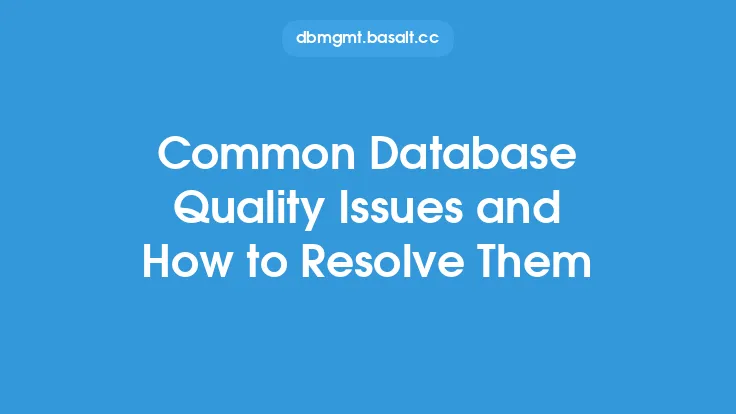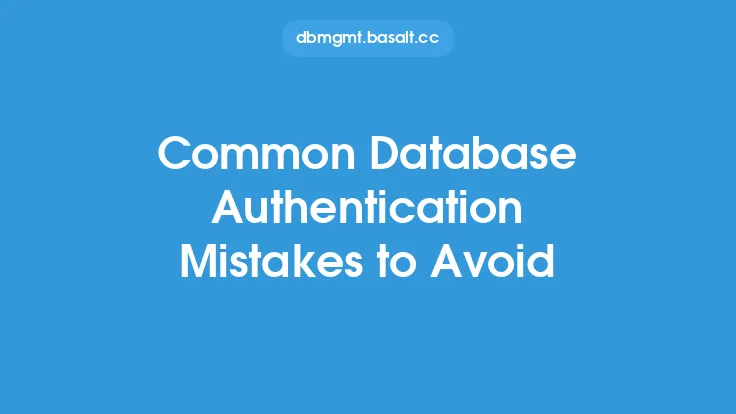When designing a database schema, it's easy to get caught up in the excitement of creating a new system and overlook some of the fundamental principles that can make or break the success of your project. Database schema design is a critical aspect of database design, and mistakes made during this phase can have far-reaching consequences, affecting the performance, scalability, and maintainability of your database. In this article, we'll explore some common database schema design mistakes and provide guidance on how to avoid them.
Introduction to Database Schema Design Mistakes
Database schema design mistakes can be categorized into several areas, including data modeling, table structure, indexing, and data typing. These mistakes can lead to data inconsistencies, slow query performance, and difficulties in maintaining and scaling the database. To avoid these mistakes, it's essential to have a solid understanding of database design principles and to follow established best practices. In the following sections, we'll delve into some of the most common database schema design mistakes and provide tips on how to avoid them.
Insufficient Data Modeling
One of the most common mistakes in database schema design is insufficient data modeling. Data modeling involves creating a conceptual representation of the data and its relationships. It's a critical step in the database design process, as it helps to identify the entities, attributes, and relationships that will be stored in the database. Insufficient data modeling can lead to a database schema that is not well-organized, making it difficult to maintain and scale. To avoid this mistake, it's essential to invest time and effort into creating a comprehensive data model that accurately reflects the requirements of your application.
Poor Table Structure
Poor table structure is another common mistake in database schema design. Tables that are not well-organized can lead to data inconsistencies, slow query performance, and difficulties in maintaining the database. Some common mistakes in table structure include using too many columns, using columns with incorrect data types, and not using indexes effectively. To avoid these mistakes, it's essential to follow established best practices for table design, such as using a consistent naming convention, using indexes to improve query performance, and avoiding the use of unnecessary columns.
Inadequate Indexing
Inadequate indexing is a common mistake in database schema design that can have significant performance implications. Indexes are used to improve query performance by providing a quick way to locate specific data. Without adequate indexing, queries can take a long time to execute, leading to slow application performance. To avoid this mistake, it's essential to understand how indexing works and to use indexes effectively in your database schema. This includes creating indexes on columns used in WHERE and JOIN clauses, using composite indexes to improve query performance, and avoiding the use of indexes on columns with low cardinality.
Incorrect Data Typing
Incorrect data typing is another common mistake in database schema design. Using the wrong data type for a column can lead to data inconsistencies, slow query performance, and difficulties in maintaining the database. For example, using a string data type to store numeric data can lead to slow query performance and make it difficult to perform arithmetic operations on the data. To avoid this mistake, it's essential to choose the correct data type for each column, taking into account the type of data that will be stored and the operations that will be performed on the data.
Lack of Data Validation
Lack of data validation is a common mistake in database schema design that can lead to data inconsistencies and errors. Data validation involves checking the data to ensure that it meets certain criteria, such as format, range, and consistency. Without data validation, incorrect or inconsistent data can be entered into the database, leading to errors and inconsistencies. To avoid this mistake, it's essential to implement data validation checks in your database schema, using techniques such as CHECK constraints, triggers, and stored procedures.
Inadequate Security Measures
Inadequate security measures are a common mistake in database schema design that can have significant security implications. Databases often store sensitive data, such as financial information, personal data, and confidential business information. Without adequate security measures, this data can be vulnerable to unauthorized access, theft, and tampering. To avoid this mistake, it's essential to implement robust security measures in your database schema, including authentication, authorization, encryption, and access control.
Failure to Consider Scalability
Failure to consider scalability is a common mistake in database schema design that can have significant performance implications. As the database grows, the schema must be able to accommodate increasing amounts of data and user traffic. Without a scalable database schema, the database can become slow and unresponsive, leading to poor application performance. To avoid this mistake, it's essential to design the database schema with scalability in mind, using techniques such as partitioning, sharding, and distributed databases.
Conclusion
Database schema design is a critical aspect of database design, and mistakes made during this phase can have far-reaching consequences. By understanding the common mistakes in database schema design and following established best practices, you can create a well-organized, scalable, and maintainable database schema that meets the needs of your application. Remember to invest time and effort into creating a comprehensive data model, follow established best practices for table design, use indexes effectively, choose the correct data type for each column, implement data validation checks, implement robust security measures, and design the database schema with scalability in mind. By avoiding these common mistakes, you can create a database schema that is efficient, scalable, and easy to maintain, providing a solid foundation for your application.





